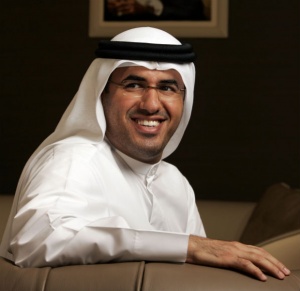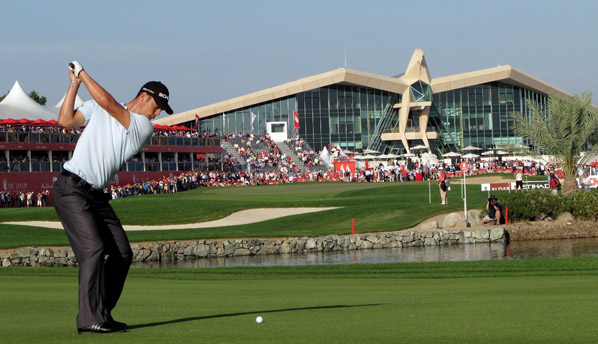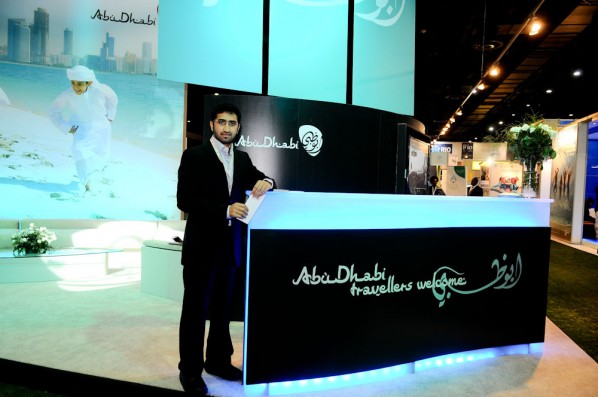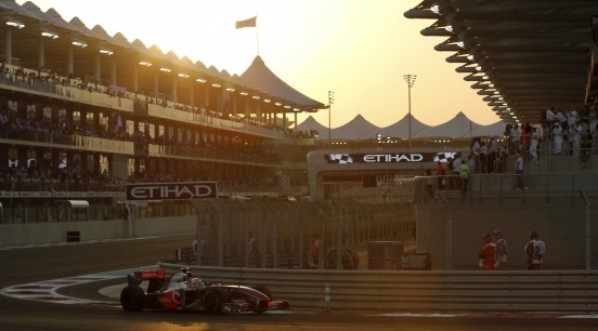BTN spotlight: Mubarak Hamad Al Muhairi, ADTA Director General

His Excellency Mubarak Hamad Al Muhairi is the Director General of the Abu Dhabi Tourism Authority. He works very closely with HE Sheikh Sultan Bin Tahnoon Al Nahyan to create the promotion and development of the emirate’s tourism sector.
Mubarak holds a number of board member positions with governmental organisations such as the Abu Dhabi Authority for Culture and Heritage, Abu Dhabi National Exhibition Centre, Abu Dhabi Media Company and Etihad Airways, the UAE’s national carrier.
Mubarak graduated from the UAE University with a degree in Civil Engineering before going on to Portland State University, USA, where he earned a master’s degree in Engineering Management.
BTN: What are your expectations and participation at this year’s ATM?
MAM: We are showcasing the destination’s biggest-ever offering with upwards of 80 products promoted in a pavilion shared by 45 stakeholders. The expanded product line up – which reflects the destination’s expanding offering – includes transport suppliers, hotel operators, major attractions, hospitality management companies, travel agents, tour operators, an international sports resort, MSC Cruises, desert, island, beach and golf resorts.
Visitors can expect to see a host of new product offerings including the international exhibition debut of the expansive Al Forsan International Sports Resort, Ayla Hotels & Resorts Management and Five Continents Hospitality. Quite simply, our message to ATM visitors is: if you’re looking for new business opportunities and partners, a visit to the Abu Dhabi pavilion is essential.

(Abu Dhabi HSBC Golf Championship)
This will be our eighth showing in the market place. We are exhibiting because the GCC market in particular is extremely important to us because it is a market on our doorstep characterised by a strong propensity for travel. Last year, the GCC, with the exception of the UAE, accounted for over 102,000 hotel guests to Abu Dhabi which was a 19 percent rise on 2009. In the first two months of this year the GCC market showed further signs of growth delivering over 20,000 hotel guests – a 14 percent rise on the same period in 2010. Of the markets, Saudi Arabia is proving the most prolific. In 2010, some 38,633 hotel guests from the Kingdom were welcomed into Abu Dhabi’s hotels – a rise of 26 percent on the previous year. The trend continued in the first two months of this year with some 9,645 Saudis staying in our hotels – a 61 percent rise on the same period in 2010.
Stronger links, specifically with the GCC trade – and most especially the trade from Saudi Arabia with the Kingdom now being Abu Dhabi’s fifth largest source market and where ADTA plans to open an office shortly.
A greater awareness of Abu Dhabi’s expanding leisure offering making it a great short-break destination for GCC families and travellers.

(The Queen and Prince Philip arrive at the Sheikh Zayed Mosque in Abu Dhabi to pay their respects to the late Sheikh Zayed bin Sultan al-Nahyan)
BTN: Will you be participating at AHIC and if so what is the significance of the event for you?
MAM: Several members of staff are attending as delegates as a stakeholder and industry learning exercise.
BTN: You were voted “World’s Leading Tourist Board” at 2010 World Travel Awards. Why do you think you won?
MAM: For a number of reasons. I believe much of it has to do with the very close way we are now working with our industry stakeholders. For instance, our Industry Professional Development Department, which was launched two years ago, is producing specialised training for licensing, classification, environment, health & safety as well as Emiratisation. This training is carried out in conjunction with some of the world’s best suppliers including Cornell University School of Hotel Administration, the University of Hawaii, School of Travel Industry Management and Hong Kong Polytechnic University, School of Hotel & Tourism Management. On the cards this year are no less than 95 training programmes – which is a significant 44 percent rise on the 74 delivered last year and the 35 in 2009. Some 4,554 people trained under this department in its first two years of existence. If this year’s increase in programmes translates directly into a pro-rata uplift in professionals trained we could be looking at around 4,900 recipients this year.

(Faisal Abdulla Al Sheikh, Events Manager, Abu Dhabi Tourism Authority, exhibiting at the inaugural World Sport Destination Expo, Johannesburg 2010)
In addition, our stakeholder programme “Partners In Progress” has gathered pace. Our quarterly Seyaha stakeholder magazine now circulates to a readership in 49 countries and our industry development committees meet regularly with our team. We have a vibrant media hosting programme – which last year ran at one media for every working day – and an intensive trade fair and overseas promotions campaign, which is now taking us for the first time to shows in Korea and the USA.
Of course much is down to the people in the authority who are working closely with stakeholders across event development and execution, our global marketing campaign, communications, strategy & policy, improving tourism standards, stepping up environment health and safety management, our international and domestic promotions and numerous business tourism initiatives. Mention should also be made of the support staff in IT, administration, purchasing, hospitality and finance.
BTN: 2010 was your most successful year yet – what do you have lined up in 2011 to keep the momentum going?
MAM: Abu Dhabi Tourism Authority has stretched its 2011 target to two million hotel guests following last year’s stellar performance when the destination achieved 1.81 million hotel guests – an 18 percent increase on 2009 and 8 percent ahead of target.
This stretch target will require a 10.5 percent rise in hotel guest numbers on 2010 with an emphasis on creative destination packaging and strengthening of the distribution system. In 2011, ADTA will focus on five specific tourism sectors – cruise, golf, education, events and culture & heritage. We will invest in these sectors and address all components of the value chain. Our destination rose superbly to the challenge in 2010 and we believe we can do it again meeting the challenge of another 4,000 plus rooms which are due on line in both business and leisure hotels and resorts.
We plan to launch a major international consumer activation programme and will announce the mechanics shortly and have already rolled out phase two of our global advertising campaign.
We are also well advanced with an attraction audit which will identify gaps in our offering and are finalising dedicated offices in Moscow, New York and Jeddah. We also have major developments coming on the business tourism front though I cannot reveal the details yet – just watch this space.
Two key 2011 milestones represent substantial opportunities. The first is the home porting, from this October, of the MSC Cruises luxury MSC Lirica liner which will sail from Abu Dhabi on 19, eight-day cruises around the Arabian Gulf.
The second milestone is the December 31/January 1 hosting of the third leg of the Volvo Ocean Race for which we will build a race village to accommodate upwards of 200,000 spectators. We are looking to all our stakeholders to join us in delivering a welcome that will stand out when the flotilla of yachts arrives at our shores. We are targeting 35,000 international visitors during the host port fortnight.
BTN: Sport Tourism is a key feature of getting the getting the Abu Dhabi brand to the world. What plans do you have in the pipeline?
MAM: We have high hopes of hosting a round of the World Rally Championship in Abu Dhabi to further our international motorsport ambitions. With Rally Abu Dhabi on the provisional 12-round, 2012 World Rally Championship calendar, the final decision on the emirate’s inclusion is dependent on the approval of the event’s business plan by the World Rally Commission in May. The World Motorsport Council will then formally ratify the final list in June.
What are some of the key growth areas in the Middle East for 2011 – 2012? What opportunities will these create for potential investors?
MAM: Cruise tourism is an expanding area and offers significant opportunities for new attractions and specialised operators. We are also actively investigating the feasibility of an educational tourism strategy, which again, will hold out immense opportunities for suppliers.
What will be the main challenges for the UAE over the next 12 months and in what ways are you addressing these?
MAM: Again ADTA’s focus is Abu Dhabi and within this context some of the key challenges which also present elements of opportunity include the impact of regional unrest on perceptions of safety within Middle East destinations. We are in constant communication with overseas media and stakeholders to reiterate our reputation as one of the safest and politically stable destinations within the region. We have been heartened by the fact that there appears to be increased awareness overseas of the geography of the region and the distance between the various destinations. We are continuing with our dynamic global marketing push, allied trade and consumer programmes, especially trade and media famils, working with key stakeholders such as Etihad to expand inbound capacity and generally improving the strength and appeal of the offers we put into the market place.

(The Yas Marina Circuit at sunset)
Another issue we are focused on is keeping accommodation demand and supply in reasonable balance. Not too long ago, Abu Dhabi had an historical issue of under supply of hotel accommodation capacity which negatively impacted our value proposition and competitiveness in business and leisure tourism. This has been addressed over last year and this, with the delivery of thousands of additional hotel rooms. ADTA recognises that part of the challenge now is to maintain healthy operating conditions for hotel investors and operators. Building demand, especially leisure, is an obvious opportunity however we will also continue to monitor supply, provide transparent information about destination performance, provide insight to analysts/consultants preparing feasibility studies, identify optimal occupancy ranges for the sector and seek to address opportunities for cost savings in regulations/requirements. Ultimately however investment and development decisions are made by the private sector.
We are also engaged with improving our industry’s distribution packaging performance. Tourism is a maturing industry especially within our emirate. Our colleagues in Dubai have over the last 15-20 years created an excellent example of a flexible, responsive and aligned tourism sector which efficiently links the experiences and tourism assets of the emirate with potential customers. Abu Dhabi’s tourism sector is rapidly evolving and improving engagement with the distribution sector, packaging and delivery of tourism product to potential customers. ADTA will continue to facilitate this process through platforms such as international offices, trade and consumer show participation, incentive programmes, such as Abu Dhabi Horizons which supports innovative distribution, training and market insight.
Overall our eye is firmly fixed on continuing the emirate’s tourism growth trajectory. ADTA has a clear plan and target for long term growth outlined in the Abu Dhabi Government’s 2030 policy vision. It is encouraging that despite substantial disruptions to the tourism sector globally we have been able to maintain growth. In recent times, and for the first quarter of 2011, this trajectory has returned double digit growth in hotel guests. ADTA will continue to pro-actively promote our emirate as a tourism destination under the umbrella of our global destination campaign, trade and media familiarisation programme, public relations, major events such as the hosting of the third leg of the Volvo Ocean Race 2011, expanding international office networks and our trade/consumer roll call. New products and experiences continue to be delivered from world class beachfront hotels, golf courses, theme parks to the first institutions in the Saadiyat Island Cultural District at the end of 2013. The momentum we started in 2004 with the creation of Abu Dhabi Tourism Authority continues to gather pace.

(Ferrari World Abu Dhabi is enjoying global success)
What will be the regional impact of Qatar hosting the FIFA World Cup in 2022 and where are the opportunities for hotel investors?
MAM: The 2022 FIFA World Cup will be of major significance for the entire region and especially the GCC countries. It will reinforce our credibility as one of the world’s major tourism destinations and our capacity to host the pinnacle of sporting events. Qatar has an ambitious infrastructure development plan in place to meet the logistical requirements of the World Cup. The opportunities for investors, particularly hotel investors, flowing from this plan are obvious. There is also little doubt that surrounding countries will also benefit from the coverage and demand generated. This demand could arrive in the form of unmet accommodation requirements or pre and post itineraries for rest, recreation and exploration.
What are your predictions for travel and tourism trends in the Middle East over the next decade?
MAM: The next decade will be a period of consolidation and expansion for Middle East tourism. The region’s previous crossroads role will reassert itself in the form of major aviation hubs, particularly in the UAE. The conversion of large volumes of transit traffic to stopover and point-to-point will increase as our product proposition strengthens and matures.
Cruise tourism will become increasingly significant within the region already evidenced by growth in home porting activity by the world’s major cruise companies.
From an administration/regulation perspective there will be increased intraregional co-operation through formal or information marketing, co-ordination structures, potentially regional visas e.g GCC cruise visa echoing models which have emerged in other regions. Within the UAE early versions of national tourism organisations and structures will mature to deliver a stronger UAE presence in international tourism marketing.
For Abu Dhabi the next decade will deliver the centrepiece of our tourism proposition – the Saadiyat Island Cultural District – a globally significant collection and concentration of iconic cultural institutions within a breathtaking urban environment.
The concerted programme of culturally-based tourism asset development, which is being pursued by many Middle East countries, will coalesce into a globally significant reassertion of the region’s important historical role in a modern context.
At the same time we may also see the emergence of increased travel products tailored to embrace the social/cultural expectation of Muslim travellers from around the world.
Sustainability and technology will become increasingly important and integrated into the tourism proposition especially as new centres of excellence such as Abu Dhabi’s zero-carbon Masdar project power up.
Quality products for rest and recreation such as resorts, retail theme parks and the like will continue to be important mass market propositions however visitors from within the region and further abroad will increasingly look for products which offer genuine cultural engagement. New forms of boutique accommodation, lodges, bed and breakfast/homestyle properties will also emerge. A new range of attractions/experiences based on world class delivery, interpretation and experience of history, heritage, nature, science and technology in the region will also be delivered.
AbuDhabi.mobi
With the emirate going from strength to strength, City.Mobi has launched abudhabi.mobi – this definitive guide provides you need to know about this incredible destination, from entertainment info to booking hotels and airport transfers.
For more information about Abu Dhabi visit www.visitabudhabi.ae

